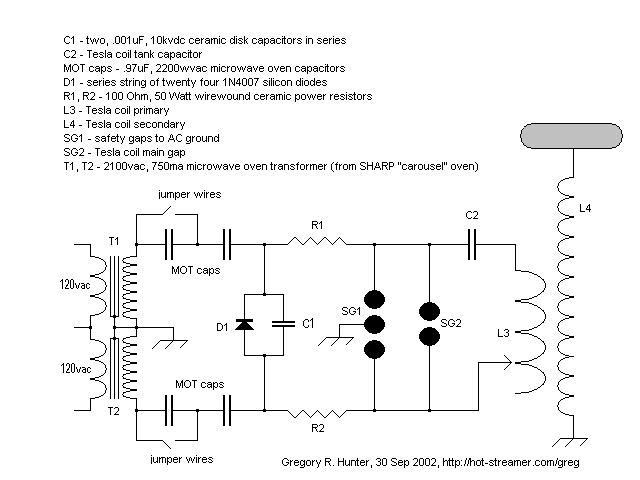
Mark III Twin MOT Supply
After thinking over the diode failure problem with my "tamed" twin MOT power supply with voltage doublers, I decided to quit messing around and return to a known good design. I'm refering to my original twin MOT supply, which ran at full throttle for months without popping any diodes. Apparently, the output chokes on the "tamed" supply are not protecting the diodes adequately. I don't know if the little airwound chokes are ringing up to high potential, or if they simply lack the inductance to block any RF. No matter, the resistor output version held up much better, so I decided to be sensible and go back to a proven design. The main difference in this new "Mk III" version is that I have wired it for 120vac instead of 240vac. Also, I used new, Ohmite brand 100 Ohm/50W ceramic wirewound resistors from Mouser Electronics. Another refinement is the addition of an extra pair of MOT caps in series in order to cut the current draw down a bit for 120vac service. I repackaged the diodes to make the string easier to replace, just in case. The diodes are still bypassed by two 1000pF/10kv ceramic disk capacitors in series. You can't see them because they are hidden inside the bit of PVC pipe the diodes are wrapped around.

So far the diodes have held up fine. The output sparks are most satisfying at 1700VA AC input. Just for grins I jumpered two of the MOT caps out of the doubler circuit, so the thing was charging only one pair of MOT caps for roughly 3200VA AC input. I plugged the sucker gap into a different AC branch to avoid tripping the 20A breaker. To my surprise, the Mk III did not instantly trip the little 120vac breaker. I only ran it for short runs--no more than 10 or 15 sec at a time. The New & Improved Junk Box Coil likes the stiffer current!
(Click these pictures if you want a larger image)
There's not much more to say about the new twin MOT supply Mk III. It has earned it's place back on my benchtop, at least as long as it doesn't develop an appetite for diodes. I'm going to run it at every opportunity for the next few months and see how diode life holds up. Makes nice sparks--at least for now. Check out the digital spark photo. Note the safety gaps firing on the Mk III. Click on the image for a short slide show.(GRH)